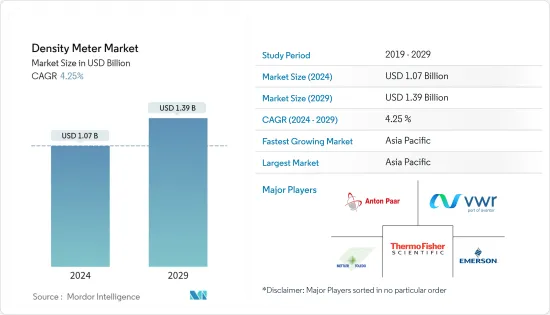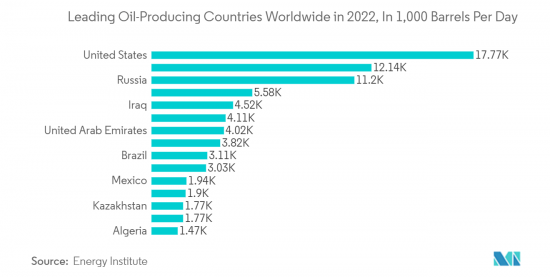PUBLISHER: Mordor Intelligence | PRODUCT CODE: 1405349

PUBLISHER: Mordor Intelligence | PRODUCT CODE: 1405349
Density Meter - Market Share Analysis, Industry Trends & Statistics, Growth Forecasts 2024 - 2029

The Density Meter Market size is estimated at USD 1.07 billion in 2024, and is expected to reach USD 1.39 billion by 2029, growing at a CAGR of 4.25% during the forecast period (2024-2029).
The growth of the density meter market can be attributed to smart factories' development and the increased demand to accurately measure the density of the fluids used in or during various production processes. Also, the stringent government regulations in the United States and European countries to regulate emissions drive market growth.
Key Highlights
- A comprehensive quality assurance covering the entire production process is essential in any industrial operation. Density measurements are commonly used for this purpose, especially in the chemical, pharmaceutical, petrochemical, and food & beverage industries. They allow the manufacturer to analyze raw materials, semi-finished and finished products, and the manufacturing steps regarding several factors.
- For instance, in chemical plants, a density meter is used for many reasons for the common bulk chemicals and the specialty and proprietary products. Acids, caustics, solvents, resins, slurries, polymers, elastomers, and more are measured using a density meter. Furthermore, pure chemicals and solutions are also measured.
- Also, rapid industrialization, in line with the technological advancement in water treatment technology, plays an essential role in the demand for liquid density meters. High growth and innovation in the water and wastewater industry create the need for a simple laboratory device to maintain and operate. Because of this, the demand for ultrasonic liquid density meters increased significantly. Further, growing applications of density meters in the plastics and rubber industry create growth opportunities.
- The COVID-19 pandemic and associated lockdown restrictions worldwide affected industrial activities that witnessed a disruption in manufacturing operations and supply chains worldwide. Under these circumstances, multiple industries worldwide saw a massive decline in revenue and profits, leading to many employees and workers being laid off, resulting in an overall loss to industrial production activities. However, with the onset of COVID-19, multiple end-user industries in the market studied were affected by reduced operations, temporary factory closures, etc.
Density Meter Market Trends
Oil and Gas Industry to Hold Significant Market Share
- Oil and gas is a wide-ranging industry encompassing many processes and applications. Some of these might be roughly grouped into basic categories: exploration, extraction, production, processing, distribution, and transportation. Most applications include monitoring the density of oil and gases transported for various purposes.
- The oil and gas sector is one of the largest end-users of density meters. In the oil and gas industry, density meters are utilized in downstream processes, wherein purification and assessment of the purified sample are measured before manufacturing. Also, the dense meter is used in various application sectors such as tanker truck and railcar loading stations, product identification on multi-product pipelines, product quality control in the production process, and mass measurement in aircraft refueling applications.
- The oil and gas industry is expanding with the growth of industrialization and the demand for energy resources. For instance, according to the International Energy Agency, the Asia-Pacific region was the highest importer and consumer of natural gas. China alone accounted for two-thirds of the demand for natural gas globally.
- Moreover, the process industries depend on technical equipment to maintain uniformity and quality throughout the crude material, wherein the density meter plays an important role. The transition would force the oil and gas production sector to accelerate the production rate, increasing demand for machinery and testing equipment, including density meters, thereby driving the market's growth.
- The oil and gas sector is one of the key end users of density meters. The primary market demand comes from the downstream sector of oil and gas. The purity of the sample is measured before manufacturing to ensure operational safety and efficiency in downstream facilities, such as plants and refineries.
- The market is witnessing multiple product innovations. In May 2022, Flexim launched FLUXUS H831. This explosion-proof and non-intrusive meter can determine operational density, density at base conditions, and many other variables in the oil and gas industry.

Asia-Pacific to Witness Significant Growth
- The increasing industrialization in Asia-Pacific makes the region one of the potential markets for density meters. The process automation industry is also expected to avail of various opportunities in Asia-Pacific. India is expected to provide more opportunities for the process automation industry in the coming years because of its political and global reformation.
- According to the India Brand Equity Foundation, in May 2022, ONGC announced plans to invest USD 4 billion from FY22-25 to increase its exploration efforts in India. The oil demand in India is projected to register a 2 times growth to reach 11 million barrels per day by 2045.
- The Asia-Pacific's oil product demand by 2050 is expected to rise to 38.8 million b/d. The increased demand for oil products can be ascribed to the rapid development in the region, particularly in countries such as India, China, Indonesia, and Japan.
- The natural gas consumption was around 575.2 billion cubic meters in 2010, which rose to 918.3 billion cubic meters in 2022-totaling a 22.7% share of global natural gas consumption. Similarly, oil consumption in the region was 27,963 thousand barrels daily. In 2021, it was around 35,806 thousand barrels daily, making the Asia Pacific region the biggest consumer of oil products globally.
- Further, owing to the increase in the number of food & beverage and pharmaceutical companies in Asia-Pacific and the focus on expanding the operations & manufacturing units across different parts of Asia-Pacific, the demand for density meters is predicted to grow substantially. Moreover, the water and wastewater treatment industry's government initiative is vital in developing the density meter market across the Asia-Pacific region.
Density Meter Industry Overview
The global density meter market is very competitive. The market is highly concentrated due to the presence of various small and large players. All the major players account for a large share of the market and are focusing on expanding their consumer base across the world. Some of the significant players in the market are ABB Ltd, Azbil Corporation, Endress+Hausar AG, Emerson Electric Corporation, Toshiba Corporation, Honeywell International Inc., KROHNE Messtechnik GmbH, Anton Paar GmbH Mettler-Toledo International Inc. VWR International (Avantor) Berthold Technologies GmbH & Co.KG Emerson Electric Co. Red Meters LLC Schmidt + Haensch GmbH & Co. Thermo Fisher Scientific, and many more. The companies are increasing the market share by forming multiple partnerships and investing in introducing new products to earn a competitive edge during the forecast period.
In February 2023, Modulyzer Flavour and Fragrance is a new analytical system developed by Anton Paar that combines density meters, polarimeters, and refractometers with an automated option to provide comprehensive information - in a single measurement cycle - on substances in the flavor and fragrance industry. Users in the quality control field can benefit from cost-reduction opportunities due to a variety of features, such as the requirement for only 10 ml sample per measurement and the ability to recover and reuse samples after a measurement. Additionally, the system can be integrated with AP Connect - Anton Paar's lab execution software - to enable the collection, review, and categorization of measurement data directly from a desktop computer.
In March 2022, digital density meters were used in the pharmaceutical industries for quality control, research, and development. Thermo Fisher and Symphogen have extended the collaboration involving improved data workflow, which supports the discovery and development of new cancer treatments. The companies provide biopharmaceutical discovery and development laboratories with innovative tools and streamlined workflows to characterize complex therapeutic proteins efficiently.
Additional Benefits:
- The market estimate (ME) sheet in Excel format
- 3 months of analyst support
TABLE OF CONTENTS
1 INTRODUCTION
- 1.1 Study Assumptions and Market Definition
- 1.2 Scope of the Study
2 RESEARCH METHODOLOGY
3 EXECUTIVE SUMMARY
4 MARKET INSIGHTS
- 4.1 Market Overview
- 4.2 Industry Attractiveness - Porter's Five Forces Analysis
- 4.2.1 Bargaining Power of Suppliers
- 4.2.2 Bargaining Power of Consumers
- 4.2.3 Threat of New Entrants
- 4.2.4 Threat of Substitutes
- 4.2.5 Intensity of Competitive Rivalry
- 4.3 Impact of COVID-19 on the Density Meter Market
5 MARKET DYNAMICS
- 5.1 Market Drivers
- 5.1.1 Expansion in Industrialization
- 5.1.2 Stringent Regulations with Regard to Food Quality and Safety
- 5.2 Market Challenges
- 5.2.1 Tradeoff Between the Accuracy and Cost of the Density Meter Equipment
6 MARKET SEGMENTATION
- 6.1 By Type
- 6.1.1 Benchtop
- 6.1.2 Module
- 6.1.3 Portable
- 6.2 By Application
- 6.2.1 Coriolis
- 6.2.2 Nuclear
- 6.2.3 Ultrasonic
- 6.2.4 Microwave
- 6.2.5 Gravitic
- 6.3 By End-user Industry
- 6.3.1 Water and Wastewater
- 6.3.2 Chemicals
- 6.3.3 Mining and Metal Processing
- 6.3.4 Food and Beverage
- 6.3.5 Healthcare and Pharmaceuticals
- 6.3.6 Electronics
- 6.3.7 Oil and Gas
- 6.3.8 Other End-user Industries (Power and Utilities, Research)
- 6.4 By Geography
- 6.4.1 North America
- 6.4.1.1 United States
- 6.4.1.2 Canada
- 6.4.2 Europe
- 6.4.2.1 United Kingdom
- 6.4.2.2 Germany
- 6.4.2.3 France
- 6.4.2.4 Rest of Europe
- 6.4.3 Asia-Pacific
- 6.4.3.1 China
- 6.4.3.2 India
- 6.4.3.3 Japan
- 6.4.3.4 Rest of Asia-Pacific
- 6.4.4 Latin America
- 6.4.5 Middle East and Africa
- 6.4.1 North America
7 COMPETITIVE LANDSCAPE
- 7.1 Company Profiles
- 7.1.1 Anton Paar GmbH
- 7.1.2 Mettler-Toledo International Inc.
- 7.1.3 VWR International (Avantor)
- 7.1.4 Berthold Technologies GmbH & Co.KG
- 7.1.5 Emerson Electric Co.
- 7.1.6 Red Meters LLC
- 7.1.7 Schmidt + Haensch GmbH & Co.
- 7.1.8 Thermo Fisher Scientific
- 7.1.9 RUDOLPH RESEARCH ANALYTICAL
- 7.1.10 Rhosonics Analytical BV
- 7.1.11 KRUSS Optronic GmbH
- 7.1.12 Ametek Inc.
- 7.1.13 Yokogawa Electric Corporation
- 7.1.14 Koehler Instrument
- 7.1.15 Toshiba Infrastructure Systems & Solutions Corporation
8 INVESTMENT ANALYSIS
9 FUTURE OF THE MARKET




